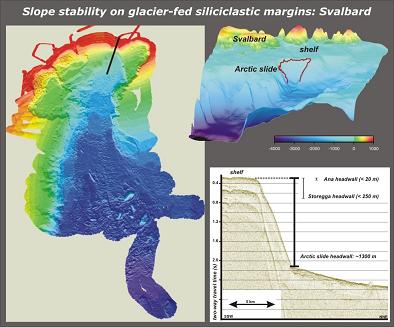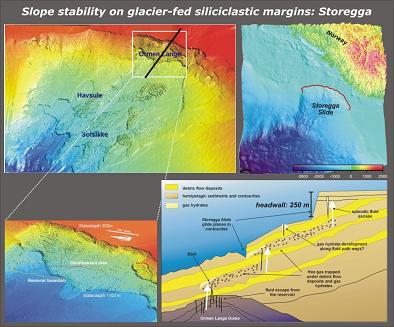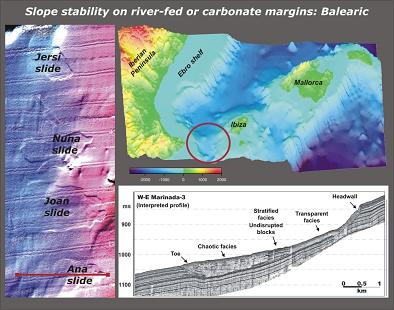Improved knowledge of the past and better understanding of the present seabed stability are essential for an understanding of the sediment dynamics of the European continental margins as a whole. Submarine slides are common and very effective mechanisms of sediment transfer from shelf and upper slope to deep-sea basins. During one single event enormous sediment volumes can be transported on very gentle slopes over distances exceeding hundreds of kilometres. Typically such events can last from less than an hour to days as documented by the 1992 Grand Banks submarine slide event that also created a tsunami, which caused devastation on adjacent coastal lowlands. In this project we focus on systematic advancement in our understanding of sediment dynamics of submarine slides in the context of global change. We prioritise the research objectives (1) slide headwall development on upper continental slopes, (2) slope stability of river-fed and carbonate margins, (3) slope stability of glacier-fed siliciclastic margins, (4) geo-mechanical controls on the formation and trigger mechanisms of submarine slides, (5) numerical modelling of sediment break up, mobility and run out, and (6) slide frequencies in regions of long-term instability in relation to sea-level change.
Project presentation
This ESF research project is in context with an international perspective of submarine mass movements and their consequences. Our research contributed to initiate the UNESCO IGCP project IGCP-511 on submarine mass movements and their consequences (2005-2009: project leaders: J. Locat, J. Mienert, R. Urgeles). Developing countries are invited to participate, and both science and society are expected to benefit from such an international focus on ocean margins. In the following we concentrate on the European continental margin.
 |
Improved knowledge of the past and better understanding of the present seabed stability are essential for an understanding of the sediment dynamics and their consequences on European continental margins. Submarine slides are common and very effective mechanisms of sediment transfer from shelf and upper slope to deep-sea basins. During one single event enormous sediment volumes can be transported on very gentle slopes over distances exceeding hundreds of kilometres. Typically such events can last from less than an hour to days as documented by the 1929 Grand Banks submarine slide event that also created a tsunami, which caused devastation on adjacent coastal lowlands. In this project we focus on systematic advancement in our understanding of sediment dynamics of submarine slides in the context of global climate and sea-level change. We prioritise the research objectives (1) slide headwall development on upper continental slopes, (2) slope stability of river-fed and carbonate margins, (3) slope stability of glacier-fed siliciclastic margins, (4) geo-mechanical controls on the formation and trigger mechanisms of submarine slides, (5) numerical modelling of sediment break up, mobility and run out, and (6) slide frequencies in regions of long-term instability in relation to sea-level change.
There is a high demand for detailed knowledge of actual seabed conditions and seabed processes on both sides of the Atlantic to improve our understanding of sediment dynamics under global change. The interactions of these research groups will improve internationalization of European science, it will lead to an exchange of ideas in areas of common interest and it will provide much better opportunities for our young scientists to do state-of-the-art research at forefront research institutions. To properly analyze slope stability and submarine flow dynamics, sediments need to be sampled in failure-prone areas to depths of zones of weakness. This type of sampling allows detailed examination of the physical properties of unstable sediments and of the known or potential failure surfaces that are bounding them. Furthermore, the effect of earthquakes and gas hydrates on slope stability is of importance for understanding the variability of slope stability. We have therefore designated seafloor regions where these types of observations can be made (Figures 1-4).
Some current results and achievements from the Arctic margin north of Svalbard (Figure 2) , the mid-Norwegian Margin (Figure 3) and the Iberian margin (Figure 4) are:
 |
 |
 |
•Arctic margin mega-sliding north of Svalbard indicate retrogressive slope failures consisting of several headwalls, one showing an enormous height of more than 1000 metres. The oldest glide or slip plane for a sediment block to fail relate to strata determined by a major onset of northern hemisphere glaciations at 2.4 Ma. The triggering and age of the slide event is presently unknown but the age could be postglacial, possibly Holocene. During this time submarine slope failures could have been triggered by tectonic activity due to postglacial uplift.
•Mid-Norwegian margin post-slide seabed instability and headwall development focuses on the northern Storegga Slide escarpment. To date, this is the only escarpment area within the giant Storegga Slide where post-slide events have been identified. These areas allow to improve understandings of post-slide activity reducing potential impacts.
•Iberian margin pressure ridges and detached blocks of shallow slides in the Ibiza Channel strongly suggest that some processes and their results are active in both mega-scale (Norwegian and Arctic margin) and mini-scale landslides (Iberian margin). The features were known from large submarine landslides but not from very small ones like those in the Ibiza Channel. This new knowledge can now be used in modelling mobility, run out, and compression of sediment material on various submarine slide scales from mini to mega slides.
•Slide frequencies on the mid Norwegian margin (from MIS = Marine Isotope Stage 1-12) indicate that submarine slope failures preferably took place when the ice margin was held at a mid or inner shelf position.
•Pore pressure developments in areas prone to sliding caused by gas hydrate dissociation are one of the important keys in our understanding of slide mechanisms. Initial laboratory test with Laponite, an artificial clay, and Freon (Trichlorofluoromethane CCl3F) are ongoing. Freon forms hydrate at 1 atm pressure and 8°C and boils at about 24°C, forming gas bubbles in the clay, making it ideal for studies of hydrate formation and dissolution processes under normal laboratory conditions. Laponite is a clear transparent gel and allows visual observation of the hydrate formation, dissolution and bubble formation phase, and thus allows improved understanding of the geomechanical processes during the phase shifts.
Project Leader:
- JürgenMienertE-Mail
- Universitetet i TromsøDepartment of GeologyTromsøNorway
Principal Investigators:
- MiquelCanals-ArtigasE-Mail
- GRC Geociencies MarinesUniversitat de BarcelonaFacultat de GeologiaDepartament d'Estratigrafia, Paleontologia i Geociències MarinesBarcelonaSpain
- Julian A.DowdeswellE-Mail
- University of CambridgeScott Polar Research InstituteDepartment of GeographyCambridgeUnited Kingdom
- HaflidiHaflidasonE-Mail
- University of BergenDepartment of Earth Sciences & Bjerknes Centre for Climate ResearchBergenNorway
- CarlBonnevie HarbitzE-Mail
- Norwegian Geotechnical InstituteDivison for Engineering Geology and Avalanches, Tsunami Modelling and PredictionOsloNorway
- Carl FredrikForsbergE-Mail
- Norwegian Polar InstituteOsloNorway
- RuedigerSteinE-Mail
- Alfred-Wegener-Institute for Polar and Marine ResearchDepartment of GeosciencesBremerhavenGermany

